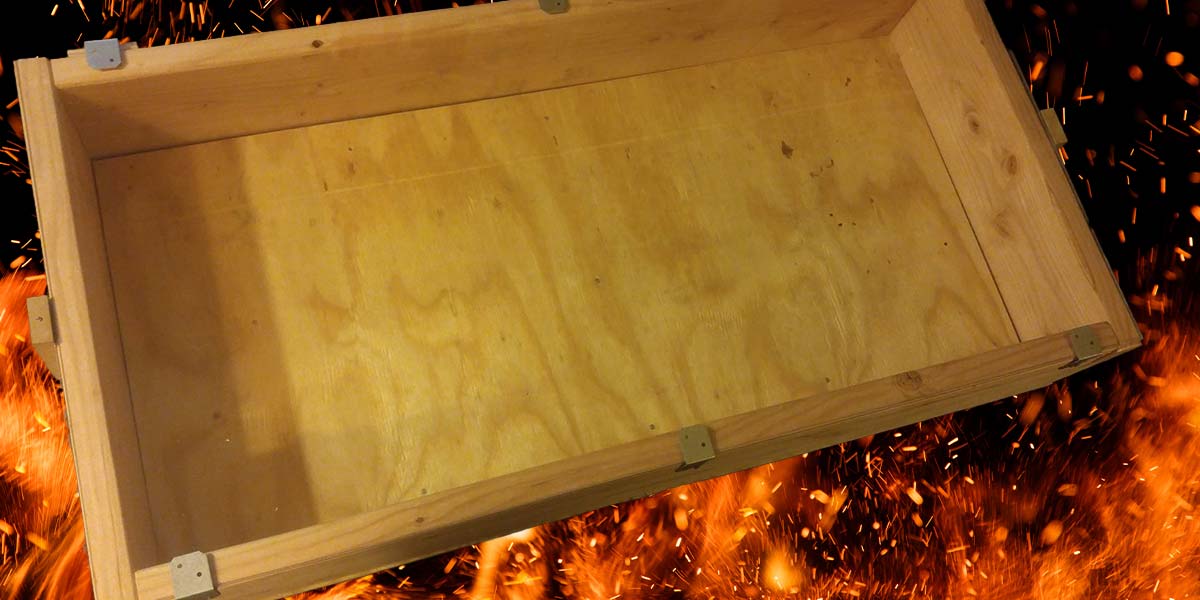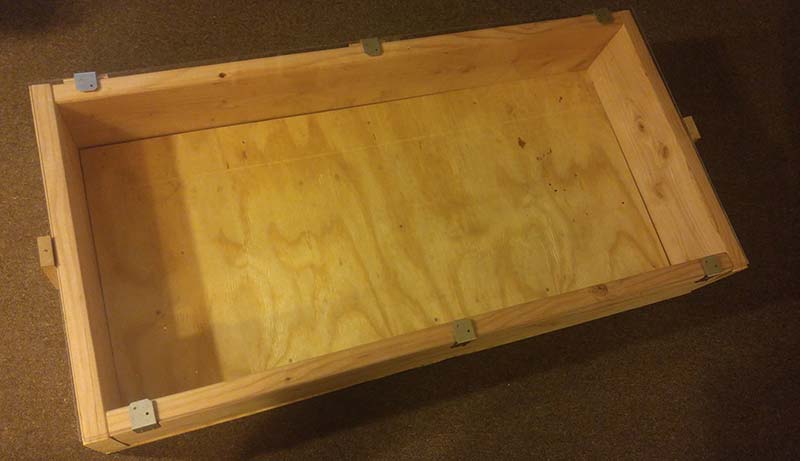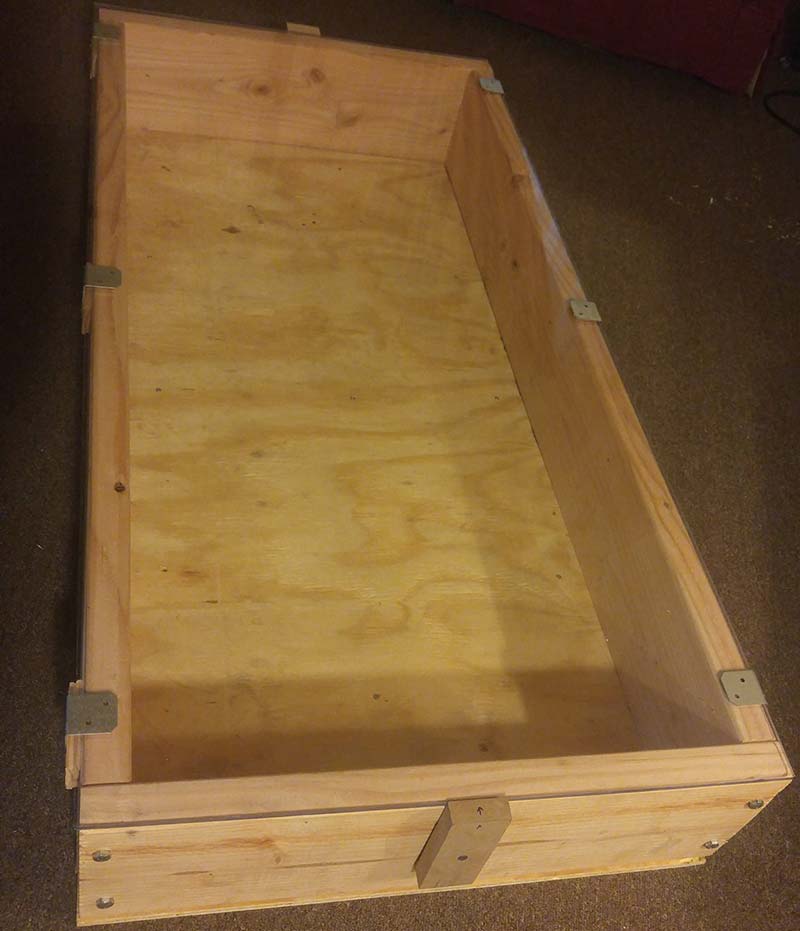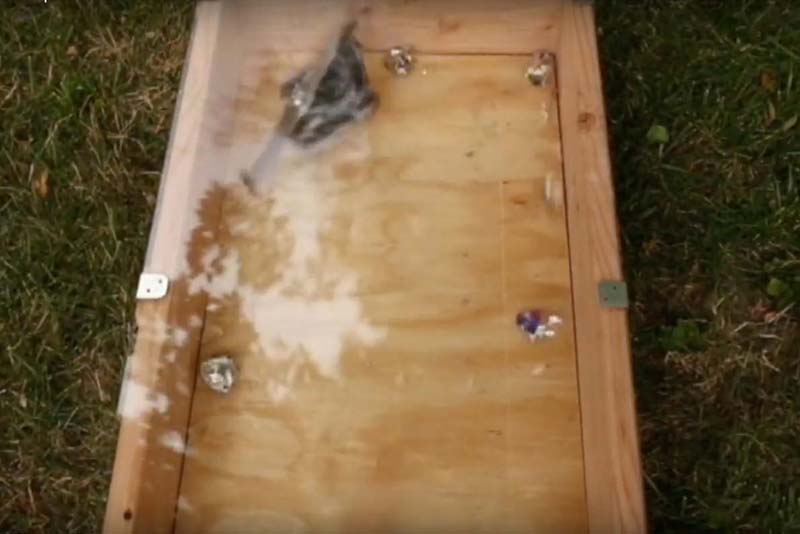
Safe(r) Beetleweight Testing: Building a Test Enclosure is Easier than I Thought
By Nik Buchholz View In Digital Edition
Any builder in any weight class will tell you that fighting bots are dangerous. As Charles Guan puts it in his Equals Zero blog, we build “machines designed to kill the [expletive] out of other machines.”
Even in small classes, robots are harder than people and I don’t want to imagine what can be done to a human body by anything that can cleave through metal. Safety personnel at events have told us to treat our bots like firearms; combat robots are weapons and should always be turned off and restrained except when in a safe environment.
Unlike a firearm, however, a fighting robot is an instrument of chaos. There is a reasonable difference between a precision engineered projectile weapon designed for human use under numerous safety standards, as opposed to an angry RC machine built in some hooligan’s garage to fight entertaining cage matches in a polycarbonate box.

Brand new Lexan is so clear!
This is not a dig on the engineering that goes into combat robots. I’m an engineering student who came into the sport of robot combat with eight years of school robotics experience under my belt, but all of this did more for my ambition than my knowledge when it came to bot fighting.
My Beetleweight builds have taught me that there is real danger in our hobby, and that even a decent combat bot has so many potentially hazardous failure modes that it’s honestly silly to even build one. A bot with a spinning weapon, for example, can throw shrapnel in any direction. It can also throw itself in any direction, or even turn itself into shrapnel and throw that. There doesn’t have to be any battle related impacts involved, either. I’ve seen many bots (my own included) eject pieces at high speed just from spinning up due to one design flaw or another.
I think this danger is part of the reason there are so few resources out there detailing how to build a safe arena or test box. Pushing the limits of materials and engineering isn’t safe. At least, not safe enough for people to feel comfortable publicly releasing arena designs and being potentially liable for arenas outside their direct control.


So, you don’t believe me that small bots are dangerous. See that grayish blur on the left? That’s not a shadow. That’s an 11 inch Chromoly steel weapon bar hurtling toward the cameraman’s face. Hooray for Lexan! (Footage frame courtesy of Endbots.)
Take this as my disclaimer: Building and testing combat robots is inherently dangerous, and even with precautions, you still operate at your own risk. This entire endeavor is silly and you should be aware of this fact if you want to take it on.
And yet, here I am, doing silly things. And here you still are, reading about it and possibly considering some silly ideas of your own. Here’s how I’ve managed to feel safer while testing my murder machine.
Our test box was designed to be built in a couple hours, on the budget and resources available to a few college students. To minimize cost, we decided that you really only need one Lexan panel for this sort of thing. This is not a spectator arena; this box sits on a garage floor and contains debris while we stand above it. Since our danger bots are horizontal spinners, we decided to put the Lexan on top, and minimize the material needed for a decent floor area by making the box very low-profile.
At roughly $50 on Amazon, the 24” x 48” x 1/4” polycarbonate panel accounted for most of the cost of this project. I would not test a Beetleweight spinner under anything thinner than this, and if you want to do impact testing with a vertical spinner, I would recommend a taller box or thicker Lexan (or ideally both).

Don’t let those holes in the brackets fool you. The Lexan is held down only by the brackets; there are no bolts.
It’s also important to mount the polycarbonate by capturing the edges in such a way that it can still flex and move without escaping the assembly. Bolting the Lexan down might seem sturdier, but this creates high-stress points in the sheet which can be starting points for a crack or fracture. Polycarbonate absorbs impacts by flexing and spreading that energy over the whole sheet. Allow it to do this for the best results.
The rest of the box consists of roughly $25 of wood, fasteners, and brackets from our local Home Depot. The walls are 2”x8” boards, cut to length and fastened at the corners with 6” lag screws. The floor is composed of two sheets of 1/2” plywood bolted together with regular wood screws. The upper sheet is cut smaller on all sides so that the four walls can fit around it snugly and sit on top of the lower layer.
This snug fit prevents the walls and roof from sliding away from the floor on a horizontal impact, as they are two separate pieces for easy disassembly and transport.
If your spinner is vertical, it’s probably worth bolting the walls down to the plywood floor to prevent them from popping up and away on impact.
The polycarbonate roof is held down by six 90-degree steel brackets that are bolted to the walls only. The Lexan sheet can slide in and out along the length of the box to open it and put robots in, and a swiveling wood latch at each end holds it in place to lock the box.

It’s a beautiful day in the neighborhood!
When storing a test box long-term, it’s best to keep it out of sunlight or hot temperatures, as this can degrade the polycarbonate and reduce its strength.
We haven’t noticed any ill effects from storing it in a garage through a Michigan winter, but I personally wouldn’t risk doing actual testing in the cold.
The entire build cost us about $75 and came together over the course of a Saturday afternoon. Considering that this is a mere fraction of the cost (in both money and time) of a weaponed Beetleweight, this is incredibly easy to justify.
There is plenty of space to drive a bot around, even with the 12” spinning blade of my bot Phantom II at full tilt, and we have mutilated many empty cans, cake pans, and even a brick within its walls.
You can see videos of this box in use, as well as our team’s fights, on our Black Lightning Robotics YouTube channel. As always, thanks for reading, and happy robot-ing! SV
Article Comments